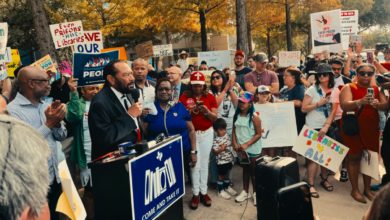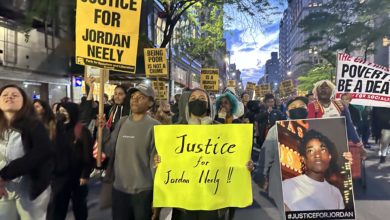A central foundation for the emergence of large scale capitalism in America was slavery. It was a brutal institution within the capitalist system used to subjugate and oppress Black people who had been kidnapped from their homes in Africa and brought to North America beginning in the 1500s. At least 12 million Africans were taken to the Americas as slaves.
The United States was founded by rich, white slaveowners. Many of its most revered buildings, including the U.S.
|
During the existence of slavery in America, Black people were not paid for their hard labor. This allowed large-scale capitalist enterprises, including big banks, insurance companies and corporations, to flourish and expand.
The criminal brutality visited upon Black people in the name of accumulating profits is the basis of the modern movement for reparations. For decades, Black people have demanded compensation from the U.S. government and corporations for the horrors of slavery and Jim Crow apartheid. Many of these institutions have not even acknowledged their complicity in the slave trade and segregation.
In October 2006, Brown University took an important step in this direction. Brown—one of America’s most prestigious Ivy League schools—not only admitted that it was founded on money derived from slavery, but it also enumerated a series of steps it will take to atone for its participation in the genocidal slave trade.
Brown has said it will increase recruitment of minority students, build a memorial to the victims of slavery, and create an institute to study slavery and injustice.
Brown’s founder, the Rev. James Manning, accepted many donations from slave owners and slave traders, including the Brown family of Providence, R.I., after whom the university is named. The Brown family fortune came from trading slaves. When the university was founded in the mid-1700s, John Brown (not the noted abolitionist who led an armed uprising in 1859 at Harpers Ferry,) the university’s treasurer was still an active slave trader.
Another Brown family member—a supposedly “liberal” person who considered himself an abolitionist—operated a textile factory using cotton supplies that came from slave plantations.
Universities founded on slavery
Brown University’s ties to the slave trade are not unique among elite universities. Most schools built prior to abolition were constructed by slave labor and funded by profits generated by slavery.
Harvard Law School, and its first endowed professorship, for example, were originally paid for with funds accumulated by selling slaves to sugar plantations in the Caribbean.
Yale’s first library came from the donations of slave traders, and its first endowed professorship was funded by and honored a slave trader.
The University of Virginia, founded and designed by slave owner, Thomas Jefferson, was built completely with slave labor.
Brown is notable, however, for its current move to enact some programs specifically designed to move toward correcting historic wrongs.
While Brown’s measures will help raise awareness about the issue and should be applauded, more must be done by these elite universities with billion dollar endowments.
Efforts to recruit more Black students are important and should be increased. But these efforts, unless overseen by working-class Black students themselves, are generally just attempts to recruit more heavily from pools of minority applicants who are already likely to go to college. This kind of recruiting excludes a huge portion of working-class Black high school students.
Brown and other universities need to take concrete steps to combat fundamental educational inequality. Like racism and oppression, such inequality is built into the capitalist system.
Concrete step that universities should take would be to make funds and resources available on a wide basis to working-class Black communities to help purchase books, computers and other educational supplies. This should be coupled with money and human resources to improve the physical facilities of community schools. More teachers should be hired, making class sizes smaller.
Basic bourgeois reforms like these would help ensure that students receive an education instead of being promoted through schools based on age.
Schools like Brandeis and UCLA in the 1960s and 70s developed innovative programs that brought high school graduates and drop-outs from oppressed backgrounds into the university system, involving them in foundational classes. These programs allowed them to take college classes and eventually earn a degree.
Brandeis took this concept even further, leaving the recruitment of minority students to Brandeis students from oppressed communities. These gains were won by strong student-led movements that demanded educational justice for Black, Latino and Native American students.
Schools like Brown should implement programs like these order to begin to pay back the great social debt they owe Black people in this country. It is also essential for Brown to move beyond its narrow apology for its historic crimes against Black people. The university should go on record as supporting the demand for reparations for all African Americans in the United States.
The wealth that built the United States and started universities like Brown must be accounted for before there can be justice.






